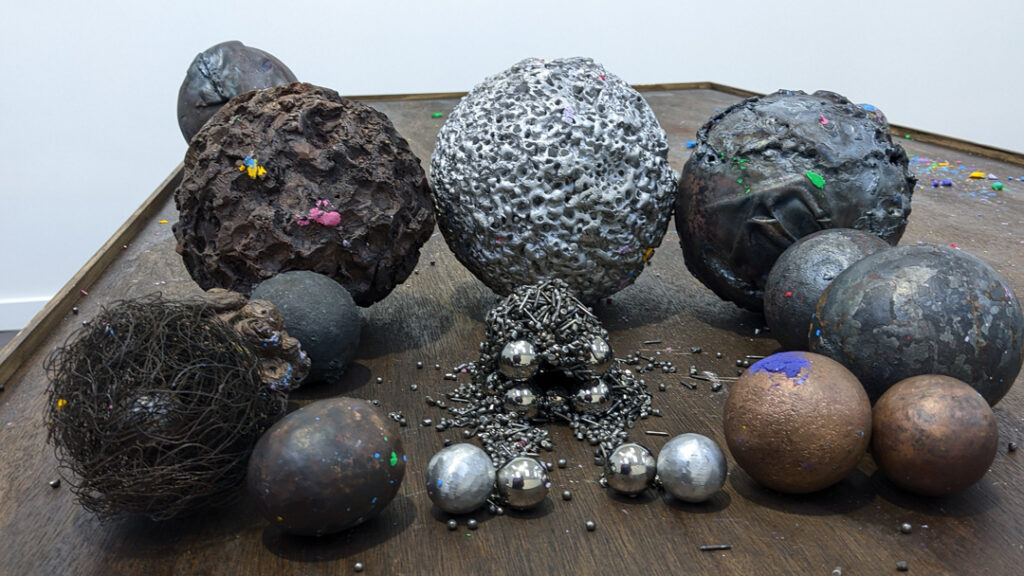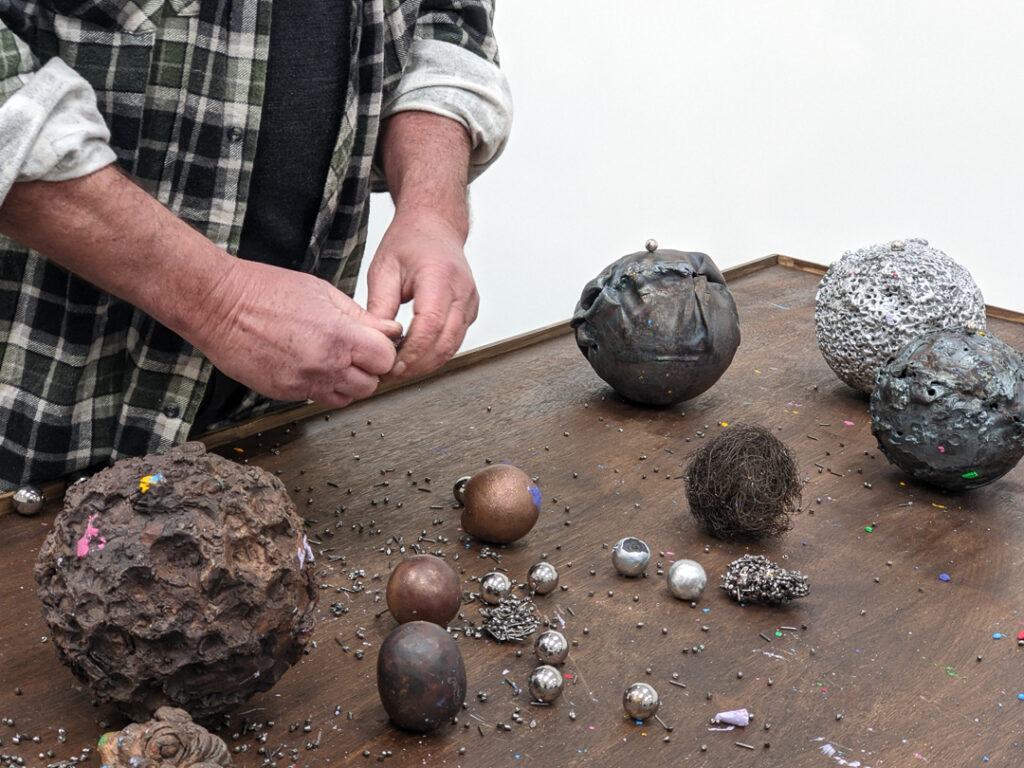
Mary Hackett; Balls; 2021; Shot, ball bearings, magnets, bronze, steel, oil pastels and aluminium; dimensions vary; photo Mary Hacket
Mary Hackett demonstrates her mettle by forging elemental spheres for life on a table
When I was very young, Mum would sit my brother and me down at a child-sized table outside in the sunshine. We lived in Tasmania, so sunshine was something to celebrate. On the table, she would place craft tools and materials. Sometimes it would be pencils and a drawing pad or a colouring book, and on occasion glue and fabric for collage. At other times it would be Plasticine (brightly coloured synthetic clay). The Plasticine would, by then, be muddy grey from use, with the colours being mixed too many times from constant play.
My brother and I would sit facing each other, playing and talking for what seemed like hours. I remember forming hollow sphere-like forms with the Plasticine by flattening some and pushing in with my thumb, slowly manipulating the synthetic clay up and over to form the desired shape. First, it was a bowl, then a cup and finally it turned into a hollow ball by smoothing it over at the top to seal it. I remember imagining what it would be like to be inside cocooned within its walls, before popping it and beginning again. I am sure that it wasn’t the only thing that I made, but the memory of this particular delight is enduring.
Now, as an adult who continues to make, I find play to be the best generator of ideas and work. Stepping into the studio with curiosity and becoming lost in play is a method I prefer within my practice. Play was the intention for Balls, an exhibition created for Radiant Pavilion 2021. Due to Covid 19 lockdowns, it was not exhibited as I had hoped until 2022 at the now defunct Clancy Gallery Naarm, as Drop the Ball. The work was created through ‘play dates’ with matter, where my ideas and expectations were matched or thwarted by the metals that I chose. The outcome was a table of balls inviting the viewer to play, not just look.
I made spheres from metals that are essential for life on Earth: iron, copper, tin, and aluminium. We can’t function without them. Humans have used these metals medicinally, industrially, and ceremonially for the duration of human knowledge. It was almost as if they enticed us to use them, to work with them. How they must have beguiled early humans and urged them to pick them up and test their mettle. They certainly charmed me.
I established a practice of raising copper (a process of hammering from a flat sheet of metal over a wooden or steel stake to form vessels) until it was either closed over, or all but. It was hard to figure out and slow to resolve, testing my understanding of silversmithing and challenging the myth that raising to a point of closure was not possible. Inspired by my childhood play, however, I proceeded with a sense that I could meet this challenge. I followed my intuition and used my hammer to push the copper over without a stake to support the work underneath. It was a laborious process, more even than elemental raising.
For the steel balls, I formed a series of hemispheres and segments at a blacksmith’s forge (workshop). The smaller steel balls were worked hot with a hammer, heating them to a bright yellow repeatedly on a coke forge (blacksmith’s hearth) before forging them (hitting with a hammer) over stakes. I then fused them together by threading a piercingly hot flame around the edges of two halves and melting a fine steel rod into the join. These balls were used in videos for my PhD where I dropped them hot into water to document the act of quenching. The video captured the dramatic swoosh of a hot ball moving through cold water and the accompanying hissing sounds of fast-cooling steel.
Other steel balls were fabricated in segments which were worked in a large and very noisy hydraulic press and then fused. During the fusing, I added other steel spheres inside. The completed balls were heavy and loud when rolled. I also scrunched steel wire into a ball form; purchased solid steel balls, a set of strong magnets, ball bearings, shot from a jeweller’s tumbler (a machine to work harden jewellery) and oil pastels.
I worked in wax to form bronze and aluminium balls, using wax that was discarded from the cheeses that I had bought and eaten, as well as sculptor’s wax. For the cheese wax, I dug and carved swirls and a hollow from a solid piece that I had scrunched together. It still smelt mildly musky, cheesy. I also melted hot wax into a concave mould and joined them together. I carved into the surface of one, dripped molten wax over the top of the other and sent them to be cast at Blueprint Sculpture, Naarm. Once they were given back to me cast and re-joined, I discovered that some pieces of metal had been trapped inside. They became rattles: a serendipitous addition.
All of the completed balls were presented on a table fabricated for purpose with a rim around the edge so that the balls would not roll off. Visitors to the gallery could sit on stools placed around the table to play and chat, reminiscent of my childhood and time spent with my brother. There were no rules to the play except that the balls had to stay on the table.
At the beginning of the exhibition, visitors tentatively rolled the balls across the table clicking them together as they did. Some people declined offers to play. Others were more willing and became thoroughly engaged. People drew, first on the table and then onto the balls themselves. Texture and sound were explored. Some balls were stacked and magnets added. Balls were rolled over oil pastels; towers and sculptures were built. The shot was sprinkled over some of the lumpier balls, filling gaps.
One visitor, sitting on their own, began catching ball bearings on magnets attached to the end of a steel ball and then flung them, catapulting the ball bearings across the table, hitting them against the rim of the opposite side. They sat and played for over an hour, until they had to leave. The next day they were back with a friend. Together, they built barriers or walls with the majority of the balls, surrounding magnets, shot and ball bearings.
I took time in the initial set-up, enjoying the process of placement, but creativity is messy. By the end of the exhibition, the work had taken on a life of its own. The table appeared more disorderly than at the beginning of the experiment. Balls, shot, magnets and oil pastels were strewn across the table. The space had witnessed fun. It was energetic and chaotic. During the exhibition, I found that play varied according to the visitor and whether they were alone or with others. All play differed to my own, which was to be expected as making the balls was play to me. I was never into ball games.
About Mary Hackett
 Mary Hackett lives and works on the lands of the Wurundjeri people of the Kulin nation in Naarm. Mary is a metalsmith maker who moves metal with a hammer, using the traditional techniques of forging and raising. Through her work, she aims to reclaim the personal from super-industrialised processes where matter, formed over millions of years, is rendered immaterial. Regardless of processes and material her jewellery and objects become a protest against the chimera that is the mass-production of traditional social symbolism. In 2019, Mary completed a PhD in Fine Art at RMIT which focused on historical and material agencies of both blacksmithing and sculpture. For this research, she produced a series of sculptures exploring matter interactions involved in a blacksmithing quench. Mary has exhibited nationally and internationally and is represented in public and private collections. Mary teaches within the Jewellery and Object Design program at Melbourne Polytechnic. For Radiant Pavilion 2024, Sue Buchanan, Mary Hackett, and Leonie Westbrook, Three Bean Mix, will engage in a three-way conversation between jeweller/makers, inviting a reconsideration of the generally discarded and overlooked ‘tin can’ and its potential as a source of material for making and for social discourse. This project can be found here: Radiant Pavilion – Three Bean Mix. Follow @m.j.hackett
Mary Hackett lives and works on the lands of the Wurundjeri people of the Kulin nation in Naarm. Mary is a metalsmith maker who moves metal with a hammer, using the traditional techniques of forging and raising. Through her work, she aims to reclaim the personal from super-industrialised processes where matter, formed over millions of years, is rendered immaterial. Regardless of processes and material her jewellery and objects become a protest against the chimera that is the mass-production of traditional social symbolism. In 2019, Mary completed a PhD in Fine Art at RMIT which focused on historical and material agencies of both blacksmithing and sculpture. For this research, she produced a series of sculptures exploring matter interactions involved in a blacksmithing quench. Mary has exhibited nationally and internationally and is represented in public and private collections. Mary teaches within the Jewellery and Object Design program at Melbourne Polytechnic. For Radiant Pavilion 2024, Sue Buchanan, Mary Hackett, and Leonie Westbrook, Three Bean Mix, will engage in a three-way conversation between jeweller/makers, inviting a reconsideration of the generally discarded and overlooked ‘tin can’ and its potential as a source of material for making and for social discourse. This project can be found here: Radiant Pavilion – Three Bean Mix. Follow @m.j.hackett




